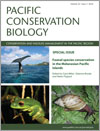
Pacific Conservation Biology
Volume 22 Number 3 2016
Special IssueFaunal Species Conservation in the Melanesian Pacific Islands
PCv22n3_EDSpecies conservation in the Pacific Islands: taking effective steps forward
PC14929Diversity and current conservation status of Melanesian–New Zealand placostyline land snails (Gastropoda : Bothriembryontidae), with discussion of conservation imperatives, priorities and methodology issues
Knowledge and conservation effort have a spatial bias. While New Zealand–Lorde Howe–New Caledonia taxa receive much needed conservation attention, those efforts are spatially discordant with the Fiji–Vanuatu–Solomon Islands centre of diversity and the emerging need in those regions for conservation action due to pressures from human activities and invasive species.
PC14927Factors affecting frog density in the Solomon Islands
This paper identifies some important factors affecting the density of frogs in the Solomon Islands. Akaike’s information criterion (AIC) was used to select the most parsimonious model of frog density. Factors identified in the selected model to predict density of 16 species were island, landform, and forest type. These findings have important management implications for the conservation of frogs in the Solomon Islands.
PC14928Freshwater ichthyofauna of the Pacific-Asia Biodiversity Transect (PABITRA) Gateway in Viti Levu, Fiji
The Pacific-Asia Biodiversity Transect (PABITRA) in Fiji has resulted in new records and new species of freshwater fish. The fauna along this transect is being threatened by reduction in forest catchment cover, construction of dams and weirs along migration routes. Several of the species are important food and totems to Fijians.
PC14930Discovery of an important aggregation area for endangered scalloped hammerhead sharks, Sphyrna lewini, in the Rewa River estuary, Fiji Islands
We explored reports that the Rewa River estuary in Fiji is a nursery area for the scalloped hammerhead shark. Results showed that juveniles do occupy the estuary, with analyses of umbilical scars and stomach contents indicating its importance as an aggregation area for the species, necessitating fishery management and protection.
PC14931Disappearing jewels: an urgent need for conservation of Fiji’s partulid tree snail fauna
Fiji has >240 species of native terrestrial snails with an endemism level of ~80%. Information on four potentially threatened endemic Partulidae species is urgently needed. The descriptive information reported here will raise awareness of these tree snails, particularly for remote island communities that have little knowledge of the snail’s uniqueness or threatened conservation status.
PC14932Placing the Fijian Honeyeaters within the meliphagid radiation: implications for origins and conservation
PC14933Cetacean diversity, common occurrence and community importance in Fijian waters
This article synthesises disparate data sources to develop a baseline of both confirmed and probable cetacean species, as well as identify areas of common occurrence and community importance within the Fijian Economic Exclusive Zone.
PC14934Population genetic structure of the goby Stiphodon rutilaureus (Gobiidae) in the New Georgia Group, Solomon Islands
The Stiphodon rutilaureus in the New Georgia Group, Solomon Islands were studied using mitochondrial analysis and microsatellites. The results indicate low or no population structure among populations of amphidromous sicydiine goby species on different islands within an archipelago. This study provides suggestions for management and conservation of fragile aquatic species.



